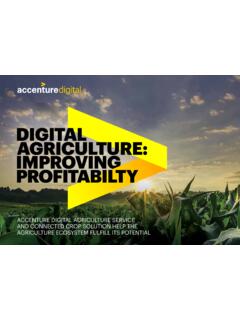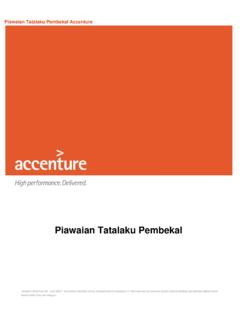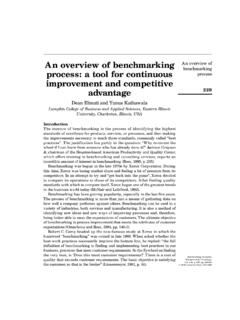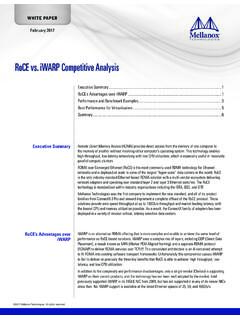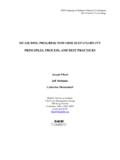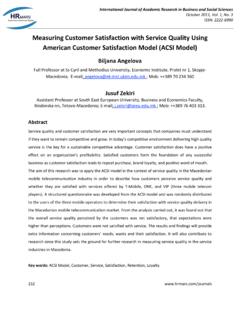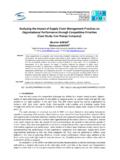Transcription of Measuring the True Profitability of Products, Services and ...
1 Measuring the True Profitability of Products, Services and CustomersFrom increased transparency comes actionable insightIn today s highly competitive and volatile global marketplace, business leaders need rich and relevant information on the true Profitability of the products and Services they offer to customers. Yet for many, the apparently simple task of Measuring Profitability of offerings is buried in a morass of confusing and often arbitrary cost allocations. The solution is to adopt a structured, methodical approach to calculating crux of the problem is that current reporting structures are primarily designed for purposes other than Measuring Profitability such as meeting regulatory requirements; optimizing tax treatments; and supporting cost budgets for cost centers, R&D and other business units.
2 Cost allocation models tend to be overly complicated as a result, and they do not reflect the true resource consumption in the value chain. Companies have most of the information they need to measure and manage Profitability , but it is scattered across multiple source systems and often, the business rules have yet to be established. They typically lack the methodology, the structures, and the analytics to consolidate the data and then calculate the true cost of the value chain. That means they may not answer basic questions such as What is the cost of the processes we are performing? or What is the cost of the products we are delivering? A bottoms-up approach reflects a disciplined and systematic approach to this challenge.
3 Data can be detangled, cleaned, and aggregated. Costs are allocated to cost elements and cost elements are assigned positions along the value chain. Business rules are established to roll up costs across the steps of the value chain and allocate them to products and customers in a transparent way. Once the system is set up, most of the heavy lifting is done. Executives can focus on analyzing results and making decisions, not gathering companies today struggle with identifying which of their offerings and which of their customers are the most profitable. They can measure revenue but not the profit associated with the product or client group which means they make decisions about what to sell, in which markets, to which customers, and at what price based on partial or inaccurate information.
4 They operate without a single version of the truth. Methods used to allocate large buckets of costs such as sales, advertising and customer service can be arbitrary and potentially inaccurate. Setting up this new structure is hard work; but once it is in place, companies may have a wellspring of data to support agile decision making. For strategic choices a company may be considering such as a price, cost, volume, or product mix change Profitability analytics can help model: Required resources in the value chain Functional impact per cost center and staff, including the impact on any outsourced step in the value chain Impact of changes in input costs, product specifications, resource levels and productivityData crunching occurs at speeds that would have been unimaginable in recent past.
5 Case in point: Every month a bank client calculates the Profitability for each of the 56,000 customers in a critical segment across 1,000 products. The calculation cycle used to be 6 months now it s down to 50 hours, with most of that time dedicated to data cleansing. The bank s ultimate goal is to complete this calculation in 20 hours, or a mere 2 business days. With the analysis results in hand, the bank can trace costs based on actual transactions and no longer rely on allocations based on percentages. As a result, the distribution of costs throughout the organization (regardless of profit center or cost center structure) has become highly transparent. A portal of multidimensional reports can give executives the basis for discussions at both strategic and tactical levels (for examples of portal reports, see the sidebar Actionable Decision Making ).
6 4 Actionable Decision MakingOnce executives have a detailed understanding of what drives costs in a company, they can figure out if their offerings are profitable, their resources are allocated to best advantage, and their products are priced and promoted to drive profitable growth. A differentiator now, such information will soon become table stakes, with business leaders drawing insights from multidimensional reports such as the examples shown European retailer wanted to increase its sourcing from China, given the high gross margin. Further analysis, however, showed the net margin was the lowest of any of the countries being considered. This insight resulted in a change in sourcing decision support tool can help aggregate information from the customer relationship management system on: Customer income Net Profitability Offerings the customer is using Customer billings by offeringBased on that data, decision makers can examine net Profitability contribution by customer segment or decompose those numbers down to the individual customer level.
7 SwedenTaiwanGermanyUnited KingdomEuropean Union (Other)ChinaUSAJ apanFrance05101520253035404550 GrossNet(%)ExampleFigure 1: Comparison of supplier gross and net margins based on their $ (000)Margin %# CustomersGross marginNet marginRevenueFigure 2: Revenue, gross and net margin correlation by individual customers56 Using information to out-think the competition7 Whether a company is primarily focused on a cost-cutting agenda or looking at a growth agenda, Profitability analytics can provide insights for driving that agenda forward. The ah-ha moment for business leaders occurs when they realize what they can do differently based on the data they now have. Three examples of better decisions in product pricing and messaging, improving process efficiency, and targeting offerings to customer segments illustrate that profitabilityA European electronics company is in the process of revamping its product pricing and promotion strategy.
8 With a Profitability analytics solution in place, the product manager was able to identify that two product categories produced the highest net profit for the company; further, three categories consumed rather than produced net profit. Next, the product manager studied the portal report that decomposed costs down to the product code and showed the cost distribution pattern. For the first time, he could see where the costs associated with each product arose and could identify the lowest acceptable price for each product the company sells. Further, he could model the effect on product Profitability of changing the cost of processes associated with manufacturing, sourcing, and selling those on product insights such as these, the electronics company.
9 Changed the pricing structure and configuration of its product portfolio Identified which products to promote to which customers, with the goal of ensuring that cash cow products (with high net Profitability ) were promoted to all customers Revised its cross-sell and up-sell strategies Identified potentially important customer segments that had not been targeted for growthThe tipping point in this process occurred when the product and sales managers finalized sales strategies based on the products customers purchased. Their goal was to ensure that customers purchased cash cows as well as products that were complementary to the cash cows. Aggregated Profitability analysis such as that shown in Figure 3 helped convince both of them of an important strategic guideline.
10 Customers that bought only complementary products were unprofitable. And customers that bought unprofitable products should be serviced differently from customers that bought promoted at the product portfolio from a holistic perspective. Try to replace money losing products with better margin ,200,0009,600,0008,000,0006,400,0004,800 ,0003,200,0001,600,000 USD5185081085192116446633511973849857889 Product numberMoney losing productsPeak profit productsCumulative profitExampleFigure 3: Aggregated product profitabilitySource: Accenture, analysis based upon a hypothetical example8 Customer profitabilityA $5B consumer goods company has an ambitious growth agenda. Through its Profitability reports, the company discovered that 20 percent of its customer base generated 80 percent of its profits, 15 percent generated 30 percent of the profits, while 50 percent produced zero profit, and 15 percent caused losses of 10 modeling different business scenarios, the product and sales managers of the company learned that: Many high-revenue customers were purchasing unprofitable products.


